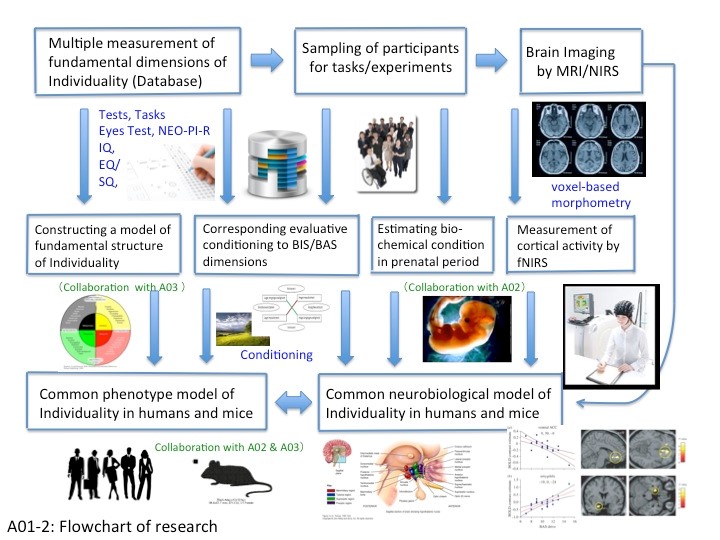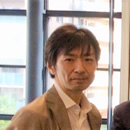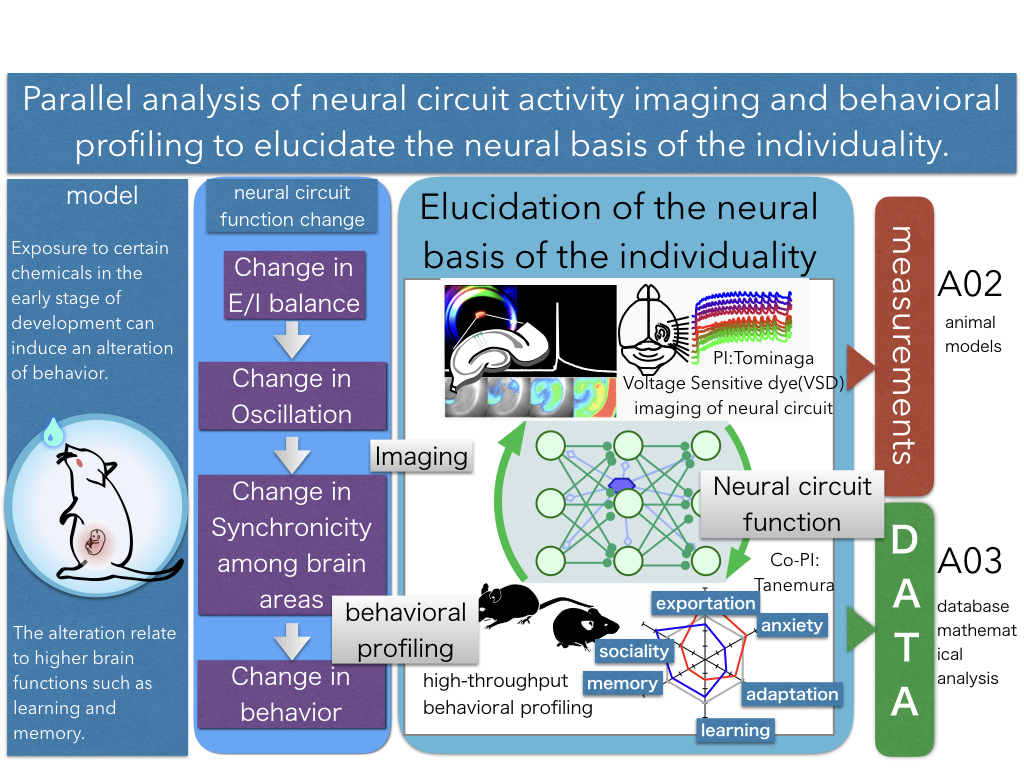Project of Planned Research
- Home
- Organization
- Project of Planned Research
A01: Fundamental research on generative brain systems for human individuality
Emergence of Individuality during Infancy and Toddlerhood

-
Project leader
Department of Language Sciences, Tokyo Metropolitan University
Associate Professor Fumitaka Homae

-
Co-Project leader
Graduate School of Education, The University of Tokyo
Professor Gentaro Taga
Further information
Message from Project leader
We know that there are individual differences in behaviors of infants as well as neonates, and even in those of fetuses. During the course of mental and physical development in infancy and toddlerhood, unique characteristics of each individual child become more apparent in the behavior, which would reflect brain function in general. In our research project, we examine how individuality of infants and toddlers emerges and appears in their behavior and brain. Cross-sectional and longitudinal data of spontaneous body movements, structural brain images and spontaneous fluctuations of brain activity will provide us promising clues to answer the question. We also focus on continuity of self in the developing period, which is critically important to form coherent characteristics of a person. Individual differences observed in the pathway of word acquisition is another main theme of the project, and we will tackle the problem by using questionnaires and brain measurements. Based on our findings in the studies of motor behaviors, brain structure, brain function, consciousness and language acquisition, we will propose a possible model of “emergence of individuality” that considers self-organized diversity of individuals, modulation of characteristics by experiences, and the constraints of physical structure.
-
Project leader
Associate ProfessorFumitaka HomaeDepartment of Language Sciences, Tokyo Metropolitan University
Research Area:
Cognitive Neuroscience, Developmental Brain ScienceE-mail:
fhomae*tmu.ac.jp
(Please convert "*" into "@".) -
Co-Project leader
ProfessorGentaro TagaGraduate School of Education, The University of Tokyo
Research Area:
Developmental Brain Sciences, BiophysicsE-mail:
taga*p.u-tokyo.ac.jp
(Please convert "*" into "@".)
Selected Publication
- Homae F: A brain of two halves: Insights into interhemispheric organization provided by near-infrared spectroscopy. NeuroImage 85, 354-362, 2014
- Homae F, Watanabe H, Taga G: The neural substrates of infant speech perception. Language and Learning, 64, 6-26, 2014
- Watanabe H, Homae F (2nd/8), Taga, G (8th/8): Effect of auditory input on activations in infant diverse cortical regions during audiovisual processing. Human Brain Mapping, 34, 543-565, 2013
- Homae F, Watanabe H (2nd/4), Taga G (4th/4), et al.: Functional development in the infant brain for auditory pitch processing. Human Brain Mapping, 33, 596-608, 2012
- Taga G, Watanabe H, Homae F: Spatiotemporal properties of cortical hemodynamic response to auditory stimuli in sleeping infants revealed by multi-channel NIRS. Philosophical Transactions of the Royal Society A, 369, 4495-4511, 2011
- Homae F, Watanabe H (2nd/4), Taga G (4th/4), et al.: Large-scale networks underlying language acquisition in early infancy. Frontiers in Psychology, 2, 93, 2011
- Watanabe H, Homae F, Taga G: Developmental emergence of self-referential and inhibition mechanisms of body movements underling felicitous behaviors. Journal of Experimental Psychology: Human Perception & Performance, 37, 1157-1173, 2011
- Homae F, Watanabe H (2nd/7), Taga G (7th/7), et al.: Development of global cortical networks in early infancy. Journal of Neuroscience, 30, 4877-4882, 2010
- Watanabe H, Homae F, Taga G: General to specific development of functional activation in the cerebral cortexes of 2- to 3-month-old infants. NeuroImage, 50, 1536-1544, 2010
- Watanabe H & Taga G: General to specific development of movement patterns and memory for contingency between action and events in young infants. Infant Behavior and Development, 29, 402-422, 2006
Close
Modeling for the fundamental dimensions of cognitive/behavioral individuality in humans and exploring the neural basis of individuality by brain imaging techniques

-
Project leader
Chiba University
Professor Akio Wakabayashi

-
Co-Project leader
Department of Nuclear Medicine and Radiology, Institute of Development, Aging and Cancer, Tohoku University. Smart-Aging Research Center, Tohoku University.
Professor Yasuyuki Taki
Further information
Message from Project leader
We realize that certain individual differences exist among human beings as well as non-human animals not only biological/physical aspects but also cognitive/behavioral characteristics. However, little evidence-based research has been reported with regard to this problem. The aim of our research project is to find the fundamental dimensions of cognitive/behavioral individuality in humans and its neural/functional basis in the brain. First, we prepare a comprehensive database of multiple measures in psychological/behavioral individual differences, such as cognitive abilities, cognitive styles and behavioral characteristics (personality traits), and construct a fundamental model of individuality. Then, we measure typical individual’s cognitive/behavioral performance as well as monitor brain activation and structure with brain imaging techniques (NIRS, fMRI), and exploring neural basis of individuality through correspondences between cognitive/behavioral characteristics and neural structure/activity in the brain. Additionally, we try to find common features of individuality and its neurological basis in the brain in humans and non-human animals, such as mice based on the conditioning experiments. Our final goal is to link a model of individuality of cognitive/behavioral aspects in humans to those in non-human animals, and find a common biological basis of individuality.

-
Project leader
ProfessorAkio WakabayashiChiba University
Research Area:
differential psychology, cognitive neuroscienceE-mail:
akiow*faculty.chiba-u.jp
(Please convert "*" into "@".) -
Co-Project leader
ProfessorYasuyuki TakiDepartment of Nuclear Medicine and Radiology, Institute of Development, Aging and Cancer, Tohoku University. Smart-Aging Research Center, Tohoku University.
Research Area:
Neuroscience, EpidemiologyE-mail:
yasuyuki.taki.c7*tohoku.ac.jp
(Please convert "*" into "@".)
Selected Publication
- Wakabayashi, A., & Kawashima, H. (2015). Is empathizing in the E-S theory similar to agreeableness? The relationship between the EQ and SQ and major personality domains. Personality and Individual Differences, 76, 88-93.
- Wakabayashi, A. (2014). A sixth personality domain that is independent of the Big Five domains: The psychometric properties of the HEXACO Personality Inventory in a Japanese sample. Japanese Psychological Research, 56, 211-223.
- Wakabayashi, A. (2013). Individual differences in empathizing and systemizing in Japanese children: Psychometric properties of the children's versions of the Empathy Quotient (EQ) and Systemizing Quotient (SQ). Japanese Psychological Research, 55(1), 12-19.
- Dinsdale, N.L., Hurd, P.L., Wakabayashi, A., Elliot, M., & Crespi, B.J. (2013). How are autism and schizotypy related? Evidence from a non-clinical population. PLoS One, 8: e63316.
- Wakabayashi, A., Ashwin, C., & Baron-Cohen, S. (2012). Do the traits of autism-spectrum overlap with those of schizophrenia or obsessive-compulsive disorder in the general population? Research in Autism Spectrum Disorders, 6, 717-725.
- Takeuchi, H., Taki, Y., et al. (2015). The impact of parent–child interaction on brain structures: Cross-sectional and longitudinal analyses. Journal of Neuroscience, 35(5):2233–2245.
- Takeuchi, H., Taki, Y., et al. (2015). The structure of the amygdala associates with human sexual permissiveness: evidence from voxel-based morphometry. Human Brain Mapping, 36(2):440-8.
- Takeuchi, H., Taki, Y., et al. (2015). Mean diffusivity of globus pallidus associated with verbal creativity measured by divergent thinking and creativity-related temperaments in young healthy adults. Human Brain Mapping, 36(5):1808–1827.
- Takeuchi, H., Taki, Y., et al. (2015). The impact of television viewing on brain structures: Cross-sectional and longitudinal analyses. Cerebral Cortex, 25(5):1188–1197.
- Sassa, Y., Taki, Y., Wakabayashi, A., et al. (2012). The correlation between brain gray matter volume and empathizing and systemizing quotients in healthy children. NeuroImage, 60, 2035-2041.
Close
A02: Fundamental research on generative brain systems for animal individuality
Epigenetic memory in neural stem cells establishing individuality

-
Project leader
Graduate School of Medical Sciences, Kyushu University
Professor Kinichi Nakashima

-
Co-Project leader
Graduate School of Integrated Sciences for Life, Hiroshima University
Professor Takuya Imamura
Further information
Message from Project leader
Gene expression is affected not only by the DNA sequence but also by epigenetic modifications in DNA and histones around which DNA wraps. Thus, upon considering the variation of individuality, taking the epigenetic differences, in addition to differences in DNA sequence in the individual, into account is critical. We have previously fount that mice prenatally exposed to an anticonvulsant, also known as HDAC inhibitor, vaplroic acid (VPA) show impairments in the hippocampal neurogenesis, resulting in the deficit in learning and memory. These facts are well corresponds to human individuals who were born to epileptic mother with VPA prescription during pregnancy. Since VPA is a HDAC inhibitor which disturbs normal epigenome formation, we hypothesized that the disturbance could be memorized in neural stem cells (NSCs) in the hippocampus, causing the impairments described above. In this project, we aim at verifying the epigenetic memory in NSCs resulted from prenatal VPA exposure and elucidate the link between the epigenetic change and impairments of the brain functions. We also investigate whether the epigenetic memory and the brain functional deficits are modulated by other mice without prenatal VPA exposure, or vise versa, through the social interaction.
-
Project leader
ProfessorKinichi NakashimaGraduate School of Medical Sciences, Kyushu University
Research Area:
Neuroscience, EpigeneticsE-mail:
kin1*scb.med.kyushu-u.ac.jp
(Please convert "*" into "@".) -
Co-Project leader
ProfessorTakuya ImamuraGraduate School of Integrated Sciences for Life, Hiroshima University
Research Area:
Non-coding RNA, EpigeneticsE-mail:
timamura*hiroshima-u.ac.jp
(Please convert "*" into "@".)
Selected Publication
- Yamamoto N., Agata K., Nakashima K. & *Imamura T. Bidirectional promoters link cAMP signaling with irreversible differentiation through promoter-associated non-coding RNA (pancRNA) expression in PC12 cells. Nucleic Acids Res, 44, 5015-5022, 2016
- Noguchi H., Murao N., Kimura A., Matsuda T., Namihira M. & *Nakashima K. DNA Methyltransferase 1 Is Indispensable for Development of the Hippocampal Dentate Gyrus. J Neurosci, 36, 6050-6068, 2016
- Irie K., *Tsujimura K., Nakashima H. & *Nakashima K. MicroRNA-214 Promotes Dendritic Development by Targeting the Schizophrenia-associated Gene Quaking (Qki). J Biol Chem, 291, 13891-13904, 2016
- Tsujimura K., Irie K., Nakashima H., Egashira Y., Fukao Y., Fujiwara M., Itoh M., Uesaka M., Imamura T., Nakahata Y., Yamashita Y., Abe T., Takamori S. & *Nakashima K. miR-199a Links MeCP2 with mTOR Signaling and Its Dysregulation Leads to Rett Syndrome Phenotypes. Cell Rep, 12, 1887-1901, 2015
- Juliandi B., Tanemura K., Igarashi K., Tominaga T., Furukawa Y., Otsuka I.M., Moriyama N., Ikegami D., Abematsu M., Sanosaka T., Tsujimura K., Narita M., Kanno J. & *Nakashima K. Reduced adult hippocampal neurogenesis and cognitive impairments following prenatal treatment of the antiepileptic drug valproic acid. Stem Cell Rep, 5, 996-1009, 2015
- Matsuda T., Murao N., Katano Y., Juliandi B., Kohyama J., Akira S., Kawai T. & *Nakashima K. TLR9 signalling in microglia attenuates seizure-induced aberrant neurogenesis in the adult hippocampus. Nat Commun, 6, 6514, 2015
- Hamazaki N., Uesaka M., Nakashima K., Agata K. & *Imamura T. Gene activation-associated long noncoding RNAs function in mouse preimplantation development. Development, 142, 910-920, 2015
- Abematsu M., Tsujimura K., Yamano M., Saito M., Kohno K., Kohyama J., Namihira M., Komiya S. & *Nakashima K. Neurons derived from transplanted neural stem cells restore disrupted neuronal circuitry in a mouse model of spinal cord injury. J Clin Invest 120, 3255-3266, 2010
- Namihira M., Kohyama J., Semi K., Sanosaka T., Deneen B., Taga T. & *Nakashima K. Committed Neuronal Precursors Confer Astrocytic Potential on Residual Neural Precursor Cells. Dev Cell 16, 245-255, 2009
- Kohyama J., Kojima T., Takatsuka E., Yamashita T., Namiki J., Hsieh J., Gage F.H., Namihira M., Okano H., Sawamoto K. & *Nakashima K. Epigenetic regulation of neural cell differentiation plasticity in the adult mammalian brain. Proc Natl Acad Sci USA 105, 18012-18017, 2008
Close
Analysis of genes that affect individuality.

-
Project leader
Department of Biochemistry and Cellular Biology
Director Mikio Hoshino

-
Co-Project leader
National Institute of Neuroscience, NCNP
Section Chief Takayoshi Inoue

-
Co-Project leader
Department of Cell Pharmacology Graduate School of Medicine, Nagoya University
Associate professor Mutsuki Amano
Further information
Message from Project leader
It is believed that genetic and environmental factors affect the individuality of humans as well as other species. In this project, we approach the genetic issue through analyzing the Autism susceptibility candidate 2 (AUTS2) gene. The AUTS2 protein orchestrates intracellular cytoskeleton contributing to neural network formation, while it also regulates transcription of various genes that are probably important for neural functions. Mutations in this gene cause a variety of psychiatric disorders, such as schizophrenia, autism spectrum disorders, ADHD, depression. In addition, the AUTS2 genome region is genetically very fragile. These facts suggest that a subtle mutation may change a character or individuality of a person, even though the mutation is not severer enough to lead to a psychiatric disease. In this study, we investigate the relationship between the change of individuality/character and AUTS2 mutations by using mouse models.
Evolutionally, AUTS2 is one of the most rapidly changed genome sequences since the bifurcation of Neanderthal and humans. We believe that evolutional change of AUTS2 genome may account for acquiring the human nature, such as higher brain functions. Therefore, we also investigate this gene from such an evolutional point of view.
-
Project leader
DirectorMikio HoshinoDepartment of Biochemistry and Cellular Biology
Research Area:
Neuroscience, Developmental BiologyE-mail:
hoshino*ncnp.go.jp
(Please convert "*" into "@".) -
Co-Project leader
Section ChiefTakayoshi InoueNational Institute of Neuroscience, NCNP
Research Area:
Molecular neurodevelopmental biology, Developmental engineeringE-mail:
tinoue*ncnp.go.jp
(Please convert "*" into "@".) -
Co-Project leader
Associate professorMutsuki AmanoDepartment of Cell Pharmacology Graduate School of Medicine, Nagoya University
Research Area:
Cell Biology, BiochemistryE-mail:
m-amano*med.nagoya-u.ac.jp
(Please convert "*" into "@".)
Selected Publication
- Hori K, Nagai T, Shan W, Sakamoto A, Abe M, Yamazaki M, Sakimura K, Yamada K, Hoshino M: Heterozygous disruption of Autism susceptibility candidate 2 causes impaired emotional control and cognitive memory. PLoS One, 10, e0145979, 2015.
- Hori K, Nagai T, Shan W, Sakamoto A, Taya S, Hashimoto R, Hayashi T, Abe M, Yamazaki M, Nakao K, Nishioka T, Sakimura K, Yamada K, Kaibuchi K, Hoshino M: Cytoskeletal regulation of AUTS2 in neuronal migration and neuritogenesis. Cell Reports, 9, 2166-2179, 2014
- Seto Y, Nakatani T, Masuyama N, Taya S, Kumai M, Minaki Y, Hamaguchi A, Inoue YU, Inoue T, Miyashita S, Fujiyama T, Yamada M, Chapman H, Campbell KJ, Magnuson MA, Wright CV, Kawaguchi Y, Ikenaka K, Takebayashi H, Ishiwata S, Ono Y, Hoshino M: Temporal identity transition from Purkinje cell progenitors to GABAergic interneuron progenitors in the cerebellum. Nature Communications, 5, 3337, 2014
- Yamada M, Seto Y, Taya S, Owa T, Inoue YU, Inoue T, Kawaguchi Y, Nabeshima Y, Hoshino M: Specification of spatial identities of cerebellar neuronal progenitors by Ptf1a and Atoh1 for proper production of GABAergic and glutamatergic neurons. J. Neurosci, 34, 4786-4800, 2014
- Kawauchi T, Sekine K, Shikanai M, Chihama K, Tomita K, Nakajima K, Nabeshima Y, Hoshino M: Rab GTPases-dependent endocytic pathways regulate neuronal migration and maturation through N-Cadherin trafficking. Neuron 67, 588-602, 2010
- Fujiyama T, Yamada M, Terao M, Terashima T, Hioki H, Inoue YU, Inoue T, Masuyama N, Obata K, Yanagawa Y, Kawaguchi Y, Nabeshima Y, Hoshino M: Inhibitory and excitatory subtypes of cochlear nucleus neurons are defined by distinct bHLH transcription factors, Ptf1a and Atoh1. Development, 136, 2049-2058, 2009
- Yamada M, Terao M, Terashima T, Fujiyama T, Kawaguchi Y, Nabeshima Y, Hoshino M: Origin of climbing fiber neurons and their developmental dependence on Ptf1a. Origin of climbing fiber neurons and their developmental dependence on Ptf1a. J. Neurosci, 27, 10924-10932, 2007
- Kawauchi T, Chihama K, Nabeshima Y, Hoshino M: Cdk5 phosphorylates and stabilizes p27kip1, contributing to actin organization and cortical neuronal migration. Nature Cell Biol. 8, 17-26, 2006
- Hoshino M, Nakamura S, Mori K, Kawauchi T, Terao M, Nishimura YV, Fukuda A, Fuse T, Matsuo N, Sone M, Watanabe M, Bito H, Terashima T, Wright CVE, Kawaguchi Y, Nakao K, Nabeshima Y: Ptf1a, a bHLH transcriptional gene, defines GABAergic neuronal fates in cerebellum. Neuron, 47, 201-213, 2005
- Kawauchi T, Chihama K, Nabeshima Y, Hoshino M: The in vivo roles of STEF/Tiam1, Rac1 and JNK in cortical neuronal migration. EMBO Journal, 22, 4190-4201, 2003
- Hoshino M, Matsuzaki F, Nabeshima Y, Hama C: hikaru genki, a CNS-specific gene identified by abnormal locomotion in Drosophila, encodes a novel type of protein. Neuron, 10, 395-407, 1993
Close
Roles of postnatal neurogenesis in the establishment of individuality.

-
Project leader
The Graduate School of Biostudies, Kyoto University
Professor Itaru Imayoshi
Further information
Message from Project leader
Although mammalian neurogenesis is mostly completed by the perinatal period, new neurons are continuously generated in the subventricular zone of the lateral ventricle and the subgranular zone of the hippocampal dentate gyrus. Since the discovery of postnatal/adult neurogenesis, many extensive studies have been performed on various aspects of neurogenesis, including proliferation and fate-specification of adult neural stem cells, and the migration, maturation and synaptic integration of newly born neurons. Furthermore, recent research has shed light on the intensive contribution of postnatal/adult neurogenesis to olfactory-related and hippocampus-mediated brain functions. New neurons are continuously generated in the postnatal mammalian brain, and may contribute to diversity of the brain. In this research project, we will analyze roles of postnatal neurogenesis in the establishment of individuality.
-
Project leader
ProfessorItaru ImayoshiThe Graduate School of Biostudies, Kyoto University
Research Area:
Neural development, NeuroscienceE-mail:
imayoshi.itaru.2n*kyoto-u.ac.jp
(Please convert "*" into "@".)URL:
http://imayoshi.web.fc2.com/Itaru_Imayoshi_Ph.D./Home.html
Selected Publication
- Imayoshi, I.* Ishidate, F. and Kageyama, R.* (2015) Real-time imaging of bHLH transcription factors reveals their dynamic control in multipotency and fate choice of neural stem cells. Frontiers in Cellular Neuroscience Aug 4;9:288.
- Sakamoto, M., Ieki, N., Miyoshi, G., Mochimaru, D., Miyachi, H., Imura, T., Yamaguchi, M., Fishell, G., Mori, K., Kageyama, R. and Imayoshi, I.* (2014) Continuous postnatal neurogenesis contributes to formation of the olfactory bulb neural circuits and flexible olfactory associative learning. The Journal of Neuroscience 34: 5788-5799.
- Imayoshi, I.* and Kageyama, R.* (2014) Oscillatory control of bHLH factors in neural progenitors. Trends in Neurosciences 37: 531-538.
- Sakamoto, M., Kageyama, R.* and Imayoshi, I.* (2014) The functional significance of newly born neurons integrated into olfactory bulb circuits. Frontiers in Neuroscience May 26; 8:121.
- Imayoshi, I.* and Kageyama, R.* (2014) bHLH Factors in Self-Renewal, Multipotency, and Fate Choice of Neural Progenitor Cells. Neuron 82: 9-23.
- Imayoshi, I.*, Isomura, A. (equal contribution), Harima, Y., Kawaguchi, K., Kori, H., Miyachi, H., Fujiwara, T.K., Ishidate, F. and Kageyama, R.* (2013) Oscillatory control of factors determining multipotency and fate in mouse neural progenitors. Science (Research Article) 342: 1203-1208.
- Imayoshi, I., Sakamoto, M., Yamaguchi, M., Mori, K. and Kageyama, R. (2010) Essential roles of Notch signaling in maintenance of neural stem cells in the developing and adult brains. The Journal of Neuroscience 30: 3489-3498.
- Imayoshi, I., Sakamoto, M., Ohtsuka, T., Takao, K., Miyakawa, T., Yamaguchi, M., Mori, K., Ikeda, T., Itohara, S. and Kageyama, R. (2008) Roles of continuous neurogenesis in the structural and functional integrity of the adult forebrain. Nature Neuroscience 11: 1153-1161.
- Imayoshi, I., Shimogori, T., Ohtsuka, T. and Kageyama, R. (2008) Hes genes and neurogenin regulate non-neural versus neural fate specification in the dorsal telencephalic midline. Development 135: 2531-2541.
- Imayoshi, I., Ohtsuka, T., Metzger, D., Chambon, P. and Kageyama R. (2006) Temporal regulation of Cre recombinase activity in neural stem cells. Genesis 44: 233-238.
Close
Differential epigenetic changes in sperm: possible transgenerational effects on gene expression and behavior in individual offspring

-
Project leader
Tohoku University Graduate School of Medicine
Professor Noriko OSUMI

-
Co-Project leader
Graduate School of Arts and Letters, Tohoku University
Associate Professor Hara, Saku

-
Co-Project leader
Department of Drug Discovery Medicine, Graduate School of Medicine, Kyoto University
Associate Professor Shinya Oki
Further information
Message from Project leader
The origin of individual can be traced back to fertilization, i.e., fusion of egg and sperm, a stage when the genetic and epigenetic information of the individual is established. We have a great interest how genetic and epigenetic information is transmitted to the next generation. To challenge this issue, we focus on paternal factors that affect specific traits in offspring because maternal factors are more complex and difficult to distinguish transgenerational effect from environmental effect within the uterus. The paternal factors we would like to investigate during this Individuality Project are aging and nutrition. We have paid keen attention to epigenetic changes during spermatogenesis such as DNA methylation and histone modification. We would like to elucidate how epigenetic changes in the sperm influences on gene regulation of the offspring during development and how such changes result in difference in behavior. We also hope that our findings will unveil pathogenesis of neurodevelopmental diseases such as autism spectrum disorder that has been incureased during these decades.
-
Project leader
ProfessorNoriko OSUMITohoku University Graduate School of Medicine
Research Area:
Brain Development, EpigeneticsE-mail:
osumi*med.tohoku.ac.jp
(Please convert "*" into "@".)URL:
http://www.dev-neurobio.med.tohoku.ac.jp/english/index.html -
Co-Project leader
Associate ProfessorHara, SakuGraduate School of Arts and Letters, Tohoku University
Research Area:
Philosophy, EthicsE-mail:
plastikfeld*gmail.com
(Please convert "*" into "@".) -
Co-Project leader
Associate ProfessorShinya OkiDepartment of Drug Discovery Medicine, Graduate School of Medicine, Kyoto University
Research Area:
Developmental biology, bioinformaticsE-mail:
oki.shinya.3w*kyoto-u.ac.jp
(Please convert "*" into "@".)
Selected Publication
- Hiraoka, K., Sumiyoshi, A., Nonaka, H., Kikkawa, T., Kawashima, R., *Osumi N: Regional volume decrease in the brain of Pax6 heterozygous mutant rats: MRI deformation based morphometry. PLoS ONE. 11(6), e0158153, 2016
- Sakayori, N., Kikkawa, T., Tokuda, H., Kiryu, E., Yoshizaki, K., Kawashima, H., Yamada, T., Arai, H., Kang, JX., Katagiri, H., Shibata, H., Innis, SM., Arita, M., *Osumi N: Maternal dietary imbalance between omega-6 and omega-3 polyunsaturated fatty acids impairs neocortical development via epoxy metabolites. Stem Cells, 34(2), 470-482, 2016 (Chosen as a video summary. Wiley Altmetric Score 325)
- Nagasaki, M., et al.(Osumi, N. 40th/47): Rare variant discovery by deep whole-genome sequencing of 1,070 Japanese individuals. Nat Commun, 6. 8018, DOI: 10.1038/ncomms9018, 2015
- Kimura, R., Yoshizaki, K., *Osumi, N.: Dynamic expression of Pax6 during spermatogenesis in the mouse. J Anat. 227(1), 1-9, 2015. (Chosen as a cover article)
- Sakayori, N., Kimura, R., *Osumi, N.: Impact of lipid nutrition on neural stem/progenitor cells. Stem Cells Int. 2013: 973508, 2013
- Matsumata, M. Sakayori, N., Maekawa, M., Owada, Y., Yoshikawa, T., *Osumi, N.: The effets of Fabp7 and Fabp5 on postnatal hippocampal neurogenesis in the mouse. Stem Cells. 30(7), 1532-1543, 2012
- Tsunekawa, Y., Britto, JM., Takahashi, M., Polleux, F., Tan, SS., *Osumi, N.: Cyclin D2 in the basal process of neural progenitors is linked to non-equivalent cell fates. EMBO J. 31(8), 1879-1892, 2012. (Chosen as “Have you seen?” article)
- Matsuo, T., Osumi-Yamashita, N., et al.: A mutation of the Pax-6 gene in rat ”small eye” was associated weith migration defect of midbrain crest cells. Nat Genetics. 3(4), 299-304, 1993 (Equally contributed first author)
Close
A03: Tools and theories for generative brain systems for individuality
Deciphering the molecular basis of individuality using imaging genomic analysis and its technical development of high precision quantitative measurement

-
Project leader
Cognitive Genomics Research Group, Exploratory Research Center on Life and Living Systems (ExCELLS), National Institutes of Natural Sciences
Specially Appointed Associate Professor Yasuhiro Go
Further information
Message from Project leader
During the last decade, rapid progress of technological innovation in the field of life science have emerged. In genome science, reference genome sequence has been determined in the early 2000s, and subsequent exploration of whole genome sequencing have been extensively going on by using the next-generation sequencer (NGS), resulting in existence more than 100K human whole genome data (perhaps more). Moreover, the rise of single cell biology can facilitate the demand of high precision quantitative measurement tools for the transcriptional and epigenetic dynamics of each cell. Similarly, in neuroscience, next-generation of imaging tools have been developed including innovative microscopy methods, CT, MRI, and PET, and we can then decode neural activity, structural/functional brain imaging, molecular dynamics in vivo. Using these innovative technical advances, we aim to develop the high-precision quantitative tools for measuring "individuality," and aim to understand the molecular basis of individuality by the multidisciplinary approach in this project.
-
Project leader
Specially Appointed Associate ProfessorYasuhiro GoCognitive Genomics Research Group, Exploratory Research Center on Life and Living Systems (ExCELLS), National Institutes of Natural Sciences
Research Area:
Evolutionary Biology, NeurogenomicsE-mail:
yago*nips.ac.jp
(Please convert "*" into "@".)
Selected Publication
- *Yoshida K, Go Y, Kushima I, Toyoda A, Fujiyama A, Imai H, Saito N, Iriki A, Ozaki N, Isoda M. (2016) Single-neuron and genetic correlates of autistic behavior in macaque. Sci Adv. in press
- Carelli FN, Hayakawa T, Go Y, Imai H, Warnefors M, *Kaessmann H. (2016) The life history of retrocopies illuminates the evolution of new mammalian genes. Genome Res. 26: 301-314.
- Suzuki-Hashido N, Hayakawa T, Matsui A, Go Y, Ishimaru Y, Misaka T, Abe K, Hirai H, *Satta Y, *Imai H. (2015) Rapid expansion of phenylthiocarbamide non-tasters among Japanese macaques. PLOS ONE 10: e0132016.
- *Oishi T, Imai H, Go Y, Imamura M, Hirai H, Takada M. (2014) Sporadic premature aging in a Japanese monkey: A primate model for progeria. PLOS ONE 9: e111867.
- *Hayakawa T, Suzuki-Hashido N, Matsui A, Go Y. (2014) Frequent expansions of the bitter taste receptor gene repertoire during evolution of mammals in the Euarchontoglires clade. Mol Biol Evol. 31: 2018-2031.
- Gonda S, *Matsumura S, Saito S, Go Y, *Imai H. (2013) Expression of taste signal transduction molecules in the caecum of common marmosets. Biol Lett. 9: 20130409.
- Fukuda K, *Ichiyanagi K, Yamada Y, Go Y, Udono T, Wada S, Maeda T, Soejima H, Saitou N, Ito T, *Sasaki H. (2013) Regional DNA methylation differences between humans and chimpanzees are associated with genetic changes, transcriptional divergence and disease genes. J. Hum. Genet. 58: 446-454.
- Hayakawa T, Sugawara T, Go Y, Udono T, Hirai H, *Imai H (2012) Eco-geographical diversification of bitter taste receptor genes (TAS2Rs) among subspecies of chimpanzees (Pan troglodytes). PLOS ONE 7: e43277.
- Hirai H, Imai H, Go Y (2012) Post-Genome Biology of Primates. p.286 Springer.(Books)
- Huffman MA, Nakagawa N, Go Y, Imai H, Tomonaga M (2012) Monkeys, Apes, and Humans: Primatology in Japan. p.62 Springer.(Books)
- Matsui A, Go Y, *Niimura Y. (2010) Degeneration of olfactory receptor gene repertories in primates: no direct link to full trichromatic vision. Mol Biol Evol. 27: 1192-1200.
- *Go Y, Niimura Y. (2008) Similar numbers but different repertoires of olfactory receptor genes in humans and chimpanzees. Mol Biol Evol. 25: 1897-1907.
Close
Parallel analysis of neural circuit activity imaging and behavioral profiling to elucidate the neural basis of the individuality.

-
Project leader
Institute of Neuroscience, Tokushima Bunri University
Professor Takashi Tominaga

-
Co-Project leader
Laboratory of Animal Reproduction and Development Graduate School of Agricultural Science
Professor Kentaro Tanemura

-
Co-Project leader
National Institute of Advanced Industrial Science and Technology
Chief Senior Researcher Ichiro Takashima

-
Co-Project leader
Department of Electronics and Bioinformatics, School of Science and Technology, Meiji University
Associate Professor Riichi Kajiwara
Further information
Message from Project leader
The aim of the study is to develop a method to explore the neural circuit mechanism that generates individuality in the brain and provide it to other groups that do research in the area of "Kosei-Souhatsu-Nou." One must significantly increase the power and precision of the current measurement methods of the function of neural circuits to detect subtle differences that have led to the emergence of profound variety of individuality. Our strategy to reduce the difficulty in developing such methods is by introducing animal models with a distorted character as test subjects to develop analysis methods. We have already shown that exposure to certain chemicals in the early stage of development can induce an alteration of behavior related to higher brain functions such as learning and memory (Collaboration with Prof. Nakashima and Prof. Tanemura; Stem Cell Rep, 2015). We planned to use such animals as the evaluation axis for individuality. We have observed that the distortion accompanied overall dynamics of neural circuit activity rather than the changes in particular cells and synapses. A method to "see" the changes in neural circuit dynamics would be necessary to measure the shift. We plan to employ a voltage-sensitive dye imaging method to visualize the circuit dynamics (PI: Tominaga). To establish the measurements in neural circuit functions as a change in individuality, we will also employ a comprehensive high-throughput behavior analysis system for mice (Co-PI: Tanemura). Correlating the imaging data and the behavioral profiles of each mouse should reveal the neural basis of the individuality.

-
Project leader
ProfessorTakashi TominagaInstitute of Neuroscience, Tokushima Bunri University
Research Area:
Neurophysiology, OptophysiologyE-mail:
tominagat*kph.bunri-u.ac.jp
(Please convert "*" into "@".) -
Co-Project leader
ProfessorKentaro TanemuraLaboratory of Animal Reproduction and Development Graduate School of Agricultural Science
Research Area:
Reproductive and developmental biology, Neurobehavioral toxicologyE-mail:
kentaro.tanemura.e4*tohoku.ac.jp
(Please convert "*" into "@".) -
Co-Project leader
Chief Senior ResearcherIchiro TakashimaNational Institute of Advanced Industrial Science and Technology
Research Area:
Functional neuroimagingE-mail:
i.takashima*aist.go.jp
(Please convert "*" into "@".) -
Co-Project leader
Associate ProfessorRiichi KajiwaraDepartment of Electronics and Bioinformatics, School of Science and Technology, Meiji University
Research Area:
Functional neuroimaging, Neural Network PhysiologyE-mail:
rdkaji*meiji.ac.jp
(Please convert "*" into "@".)URL:
https://www.meiji.ac.jp/sst/grad/teacher/01/6t5h7p00000i16cl.html/e
Selected Publication
- Furukawa Y, Tanemura K, Igarashi K, Ideta-Otsuka M, Aisaki K, Kitajima S, Kitagawa M, *Kanno J. (2016) Learning and Memory Deficits in Male Adult Mice Treated with a Benzodiazepine Sleep-Inducing Drug during the Juvenile Period. Front Neurosci. 10:339. doi: 10.3389/fnins.2016.00339.
- *Tominaga T and Tominaga Y (2016). Paired burst stimulation causes GABAA receptor-dependent spike firing facilitation in CA1 of rat hippocampal slices. Front. Cell. Neurosci. 10:9. doi: 10.3389/fncel.2016.00009
- Juliandi B, Tanemura K, Igarashi K, Tominaga T, Furukawa Y, Otsuka M, Moriyama N, Ikegami D, Abematsu M, Sanosaka T, Tsujimura K, Narita M, Kanno J, *Nakashima K (2015) Reduced Adult Hippocampal Neurogenesis and Cognitive Impairments following Prenatal Treatment of the Antiepileptic Drug Valproic Acid. Stem Cell Rep. 1–14.. doi:10.1016/j.stemcr.2015.10.012
- *Tominaga T and Tominaga Y. (2013) A new non-scanning confocal microscopy module for functional voltage- sensitive dye and Ca2+ imaging of neuronal circuit activity. J. Neurophysiol 110,553—561
- Suh, J., Rivest, AJ., Nakashiba T., Tominaga T., *Tonegawa S. Direct entorhinal cortex input to the hippocampus is crucial for temporal association memory. Science (New York, NY), 334(6061), 1415–1420. (2011)
- *Tominaga T. & Tominaga Y., GABAA receptor-mediated modulation of neuronal activity propagation upon tetanic stimulation in rat hippocampal slices. Pflügers Arch, 460: 875-889, (2010)
- Nagai T, Yamada S, Tominaga T, Ichikawa M, *Miyawaki A (2004) Expanded dynamic range of fluorescent indicators for Ca(2+) by circularly permuted yellow fluorescent proteins. Proc Natl Acad Sci U S A 101:10554-10559.
- Tanemura K, Murayama M, Akagi T, Hashikawa T, Tominaga T, Ichikawa M, Yamaguchi H, *Takashima A (2002) Neurodegeneration with tau accumulation in a transgenic mouse expressing V337M human tau. J Neurosci 22:133-141.
- *Tominaga T, Tominaga Y, Yamada H, Matsumoto G, Ichikawa M (2000) Quantification of optical signals with electrophysiological signals in neural activities of Di-4-ANEPPS stained rat hippocampal slices. J Neurosci Methods 102:11-23.
- Iijima T, Witter MP, Ichikawa M, Tominaga T, Kajiwara R, *Matsumoto G (1996) Entorhinal-hippocampal interactions revealed by real-time imaging. Science 272:1176-1179.
Close
Development of Mathematical Models for Brain Systems Generating Individuality and Statistical Data Analysis

-
Project leader
Department of Mathematical Informatics, The University of Tokyo
Professor Fumiyasu Komaki

-
Co-Project leader
Statistical Mathematics Unit, RIKEN Center for Brain Science
Unit Leader Takeru Matsuda
Further information
Message from Project leader
Data are accumulating rapidly in various scientific fields today. However, it is difficult to extract information concerning individuality just by applying existing analyzing methods to big data because traditional methods tend to focus on typical data rather than outliers.
Mathematical models (or statistical models) play key roles to extract information concerning individuality from big data. Statistical models have various parameters to be adjusted and are more flexible than rigid models such as governing equations in physics, although statistical models are also built by incorporating scientific knowledge.
We formulate data concerning human and animal behavior as superposition of individuality, exterior effects, and additional noises. We extract information concerning individuality from data by using analyzing methods based on the developed mathematical models. Statistically verified models are useful for understanding of underlying phenomena generating observed data.
-
Project leader
ProfessorFumiyasu KomakiDepartment of Mathematical Informatics, The University of Tokyo
Research Area:
Statistics, Mathematical ModelingE-mail:
komaki*mist.i.u-tokyo.ac.jp
(Please convert "*" into "@".) -
Co-Project leader
Unit LeaderTakeru MatsudaStatistical Mathematics Unit, RIKEN Center for Brain Science
Research Area:
statistics, applied mathematicsE-mail:
takeru.matsuda*riken.jp
(Please convert "*" into "@".)
Selected Publication
- Kojima, M. and Komaki, F. (2016). Relations between the conditional normalized maximum likelihood distributions and the latent information priors, IEEE Transactions on Information Theory, vol. 62, pp. 539-553.
- Matsuda, T. and Komaki, F. (2015). Singular value shrinkage priors for Bayesian prediction, Biometrika, vol. 102, pp. 843-854.
- Komaki, F. (2015). Asymptotic properties of Bayesian predictive densities when the distributions of data and target variables are different, Bayesian Analysis, vol. 10, pp. 31-51.
- Komaki, F. (2011). Bayesian predictive densities based on latent information priors, Journal of Statistical Planning and Inference, vol. 141, pp. 3705–3715.
- Hirose, Y. and Komaki, F. (2010). An extension of least angle regression based on the information geometry of dually flat spaces, Journal of Computational and Graphical Statistics, vol. 19, pp.1007-1023.
- Komaki, F. (2006). Shrinkage priors for Bayesian prediction, The Annals of Statistics, vol. 34, 808-819.
- Kobayashi, K., and Komaki, F. (2006). Information criteria for support vector machines, IEEE Transactions on Neural Networks, vol. 17, 571-577.
- Tanaka, F. and Komaki, F. (2005). Bayesian predictive density operators for exchangeable quantum statistical models, Physical Review A, vol. 71, 052323.
- Komaki, F. (2004). Simultaneous prediction of independent Poisson observables, The Annals of Statistics, vol. 32, 1744-1769.
- Komaki, F. (2001). A shrinkage predictive distribution for multivariate normal observables, Biometrika, vol. 88, 859-864.
Close
Development of a Phenotype Recording and Mining System for Discovering Individuality

-
Project leader
Kyushu Institute of Technology
Professor Tomohiro Shibata

-
Co-Project leader
Graduate School of Life Science and Systems Engineering, Kyushu Institute of technology
Professor Kiyohisa Natsume

-
Co-Project leader
RIKEN BioResource Research Center Integrated Bioresource Information Division
Head Hiroshi Masuya

-
Co-Project leader
System Emotional Science, University of Toyama
Assistant professor Jumpei Matsumoto
Further information
Message from Project leader
In this team, we are developing a system that can record markerless phenotypes for identifying personality, targeting rodents such as mice. As a phenotype, not only the individual's gait but also 3-dimensional information on other body parts, and social behavior are also in our research scope. The developed system is planned to be used by the other A02 teams and also for international collaborations. The international collaboration support group enhances this activity with the development and operation of a data sharing platform. The international collaboration support group plans to build a large database of rodents’ phonotypes. We are developing data mining algorithms such as self-organization (visualization) of data, clustering, anomaly detection, etc. and a user interface easy for the researcher to use to discover "individuality" in cooperation with researchers and machines. By applying these algorithms to the large database, it is expected that we will discover novel "Individuality" indices. Furthermore, since our system could be applied to human data, we also plan to collaborate with the other A01 teams.
-
Project leader
ProfessorTomohiro ShibataKyushu Institute of Technology
Research Area:
Social Intelligence, Robotics, Biological Signal Measurement and Processing,E-mail:
tom*brain.kyutech.ac.jp
(Please convert "*" into "@".) -
Co-Project leader
ProfessorKiyohisa NatsumeGraduate School of Life Science and Systems Engineering, Kyushu Institute of technology
Research Area:
Neuroscience, Brain Information TechnologyE-mail:
natume*brain.kyutech.ac.jp
(Please convert "*" into "@".) -
Co-Project leader
HeadHiroshi MasuyaRIKEN BioResource Research Center Integrated Bioresource Information Division
Research Area:
Bioinformatics, mouse geneticsE-mail:
hiroshi.masuya*riken.jp
(Please convert "*" into "@".) -
Co-Project leader
Assistant professorJumpei MatsumotoSystem Emotional Science, University of Toyama
Research Area:
System neuroscience, Behavioral neuroscienceE-mail:
jm*med.u-toyama.ac.jp
(Please convert "*" into "@".)URL:
http://www.med.u-toyama.ac.jp/sysemosci/index.html
http://matsumotoj.github.io/
Selected Publication
- Kejriwal, N., Kumar, S. and Shibata, T. High performance loop closure detection using bag of word pairs, Robotics and Autonomous Systems, 77, pp.55-65, 2016
- Nakamura, A., Funaya, H., Uezono, N., Nakashima, K., Ishida, Y., Suzuki, T., Wakana, S., Shibata, T. Low-cost three-dimensional gait analysis system for mice with an infrared depth sensor, Neurosci Res, 100, pp.55-62, 2015
- Funaya, H., Shibata, T. Preference bias of head orientation in choosing between two non-durables. Frontiers in Psychology, 6(849), 7pages, 2015
- Okada, T., Shibata, T., Tamei, T., et al. In-Home posture evaluation and visual feedback training to improve posture with a Kinect-based system in Parkinson’s disease. Journal of Novel Physiotherapies, 4(5), 232, 7 pages, 2014
- Koganti, N., Ngeo, J.G., Tamei, T., Ikeda, K. and Shibata, T. Cloth dynamics modeling in latent spaces and its application to robotic clothing assistance. IEEE/RSJ International Conference on Intelligent Robots and Systems (IROS 2015), pp.3464-3469, 2015
- Ngeo, J.G., Tamei, T., Ikeda, K., and Shibata, T. Modeling dynamic high-DOF finger postures from surface EMG using nonlinear synergies in latent space representation. The 37th Annual International Conference of the IEEE Engineering in Medicine and Biology Society, pp.2095-2098, 2015
- Ngeo,J.G., Tamei, T., Shibata, T. Continuous and simultaneous estimation of finger kinematics using inputs from an EMG-to-muscle activation model. Journal of NeuroEngineering and Rehabilitation, 11(122), 5pages, 2014
- Ikeda, S., Shibata, T., et al. Neural decoding of single vowels during covert articulation using electrocorticography. Frontiers in Human Neuroscience, 8, 125, 8 pages, 2014
- Obayashi, C., and Tamei, T. and Shibata, T. Assist-as-needed robotic trainer based on reinforcement learning and its application to dart-throwing. Neural Networks, 53, pp.52-60, 2014
- Hayashi, K., Takenouchi, T., Shibata, T., et al. Exponential family tensor factorization: an online extension and applications. Knowledge and information systems, 33 (1), 57-88, 2012
Close
